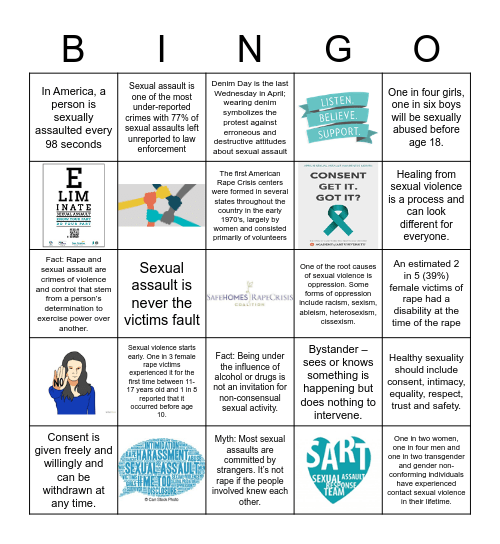

This bingo card has 13 images, a free space and 48 words: Sexual Assault Awareness Month is April, Teal is the Color used to support sexual violence survivors, In America, a person is sexually assaulted every 98 seconds, One in two women, one in four men and one in two transgender and gender non-conforming individuals have experienced contact sexual violence in their lifetime., One in four girls, one in six boys will be sexually abused before age 18., 91% of child sexual abuse survivors know their perpetrator., The first American Rape Crisis centers were formed in several states throughout the country in the early 1970’s, largely by women and consisted primarily of volunteers, One of the root causes of sexual violence is oppression. Some forms of oppression include racism, sexism, ableism, heterosexism, cissexism., Denim Day is the last Wednesday in April; wearing denim symbolizes the protest against erroneous and destructive attitudes about sexual assault, Consent is given freely and willingly and can be withdrawn at any time., Healthy sexuality should include consent, intimacy, equality, respect, trust and safety., We all have boundaries – the lines that define where we stop being comfortable and start feeling uneasy., It takes a lot of courage for survivors to disclose sexual assault., 2001 Was the first official year of Sexual Assault Awareness Month honoring sexual assault victims, survivors and their families., Sexual violence can have numerous psychological, emotional, social and physical health effects on a survivor’s well-being., Healing from sexual violence is a process and can look different for everyone., Traumatized people chronically feel unsafe inside their bodies., Breathing techniques can be a helpful way to ground yourself when you have overwhelming feelings or intense anxiety., The lifetime cost of rape per victim is more than $120,000 (CDC 2017)., Raising awareness is part of getting involved in the anti-sexual violence movement., 80-90% of rapes are committed by someone known to the victim., Sexual assault is one of the most under-reported crimes with 77% of sexual assaults left unreported to law enforcement, People with disabilities are at least three times more likely to be sexually assaulted than the people without disabilities. (Vera Institute 2017), #MeToo was founded by Tarana Burke in 2006 to break the silence around sexual violence and uplift black women and girls and to help survivors find a pathway to healing., Sexual assault is never the victims fault, Myth: Victims provoke sexual assaults when they dress provocatively or act in a promiscuous manner., Fact: Rape and sexual assault are crimes of violence and control that stem from a person’s determination to exercise power over another., ACEs Adverse Childhood Experiences, Sexual violence starts early. One in 3 female rape victims experienced it for the first time between 11-17 years old and 1 in 8 reported that it occurred before age 10., An estimated 2 in 5 (39%) female victims of rape had a disability at the time of the rape, Women with a disability are at greater risk of experiencing rape than women without a disability., Bystander – sees or knows something is happening but does nothing to intervene., Upstander - sees what happens, intervenes, interrupts or speaks up to stop the abuse., Myth #2: If a person goes to someone’s room, house, or goes to a bar, he/she assumes the risk of sexual assault., Fact: This “assumption of risk” wrongfully places the responsibility of the offender’s actions with the victim., Myth: It’s not sexual assault if it happens after drinking or taking drugs., Fact: Being under the influence of alcohol or drugs is not an invitation for non-consensual sexual activity., Myth: Most sexual assaults are committed by strangers. It’s not rape if the people involved knew each other., Fact: Most sexual assaults and rapes are committed by someone the victim knows., Among victims aged 18 to 29, two-thirds had a prior relationship with the offender., Myth: A person who has really been sexually assaulted will be hysterical, Fact: Victims of sexual violence exhibit a spectrum of responses to sexual assault., Ensuring that the physical and emotional safety of an individual is addressed is the first important step to providing Trauma-Informed Care., People who have been traumatized need support and understanding from those around them., Becoming “trauma-informed” means recognizing that people often have many different types of trauma in their lives., SA responses include: calm, hysteria, withdrawal, anger, apathy, denial, and shock., When a survivor receives an empathetic response and feels believed, respected and valued they are less likely to experience depression, anxiety, PTSD and Fear of perpetrator, shame, social stigma, lack of resources and support are some reasons victims do not report being sexually assaulted..
Sexual Assault Awareness | Sexual Assault Awareness | Sexual Assault Awareness Tu Casa, Inc | Sexual Assault Awareness Month BINGO #SAAM | Sexual Assault Awareness
Share this URL with your players:
For more control of your online game, create a clone of this card first.
Learn how to conduct a bingo game.
With players vying for a you'll have to call about __ items before someone wins. There's a __% chance that a lucky player would win after calling __ items.
Tip: If you want your game to last longer (on average), add more unique words/images to it.